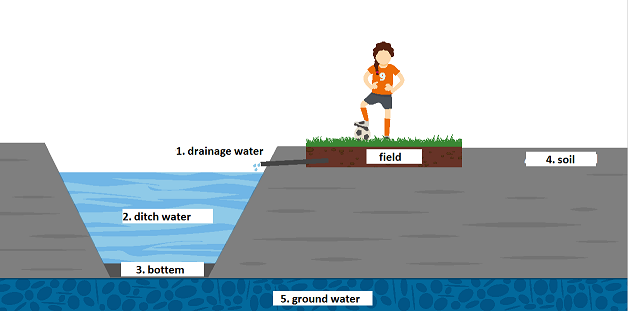The exploratory study answers 5 questions:
1. What concentrations of rubber granulate particles can be found in the soil and water surrounding synthetic turf pitches?
We found a large quantity of rubber granulate particles around the synthetic turf pitches, compared to pitches with real grass: an average of 17 grams of rubber granulate per kilo of soil. We also found rubber particles in sediments (the layer of sludge at the bottom of ditches), although in much smaller quantities: an average of 0.9 grams of rubber granulate per kilo of sediment.
Figure 1: Cross-section of synthetic turf pitch with drainage and surrounding area
2. To what extent do substances originating from rubber granulate occur in water, groundwater, soil and water beds in the area around synthetic turf pitches?
Higher concentrations of cadmium, cobalt, zinc, PAHs, mineral oils and benzothiazoles were detected in the soil borders around the pitches. The levels of zinc, cobalt and mineral oils exceed the maximum values set by the Soil Quality Decree. The levels of the other detected substances (cadmium, PAHs and benzothiazoles) do not exceed those values.
No elevated concentrations of hazardous substances were detected in the groundwater near the sampled pitches. It would therefore appear that substances are not leaching from the soil or the synthetic turf into the groundwater.
Elevated concentrations of substances that may have come from rubber granulate were found in the drainage water near four of the pitches. At one of these locations, we detected a very significant elevation in zinc levels. In the surface water at that location, the concentration of zinc exceeded the limit value by more than 250 times, and the concentration of cobalt was more than 15 times higher than the permitted level.
The ditches around synthetic turf pitches did not show higher levels of pollutants compared to the ditches around real grass pitches. This is due to the fact that the substances from the drainage water in the ditch are significantly diluted. In other words, the use of rubber granulate infill has not yet resulted in risks that affect the surface water.
In the sediments from the bottom of the ditches, we did see higher concentrations of substances near six fields, that could come from rubber granulate. However, these were not as high as the concentrations in the soil borders. The drainage water carries the substances from the sports pitches into the nearby ditches, where it migrates to the bottom (the layer of sediment). Two pitches had such high levels of zinc in the sludge that it is not permitted to be spread in surface water or on land.
3. Are there any risks to living organisms in the soil and water?
The concentrations of zinc and mineral oils that have been detected in the soil borders around the pitches could have an impact on the ecosystem. Soil policy in the Netherlands does not refer to ‘current ecological risks’ until more than 5,000 m2 of unpaved surface soil has been contaminated with a mixture of substances that represent high ‘toxic pressure’. The question is whether that scope of contamination is present in the unpaved surface soil around a sports complex in close proximity to synthetic turf pitches, and whether the levels in the entire area exceed the toxic pressure limit value.
Aquatic organismsn do not appear to be at risk; water quality in ditches beside synthetic turf pitches with rubber granulate infill is not worse than in ditches beside the control fields. Organisms living in the sediment could be adversily affected by the excessive concentrations of zinc found at several synthetic turf pitches. Accordingly, biodiversity is expected to decline here.
4. Are there any risks to people resulting from consumption of fruit and vegetables grown in local gardens that are sprayed with ditch water in the area around synthetic turf pitches, or resulting from other environmental exposure routes?
No. The ditch water does not appear to be contaminated as a result of the use of rubber granulate on the sampled synthetic turf pitches. The human health risk associated with eating fruits and vegetables from gardens that have been sprayed with that ditch water is expected to be just as low as the risk associated with using ditch water from ditches beside real grass pitches. Drinking water derived from groundwater is also safe, as are fish caught near synthetic turf pitches. Children at play who may accidentally be exposed to border soil containing rubber granulate through ingestion, inhalation or skin exposure are not at risk either.
5. Are there any risks to other animals than living organisms in the soil and water, such as birds, farm animals and pets?
No. No indications were found that birds or mammals were adversily affected by the rubber granulate that is on or near synthetic turf pitches.
Conclusions
This study shows that the use of rubber granulate infill on synthetic turf pitches may lead to local contamination of soil borders around sports pitches and of sludge at the bottom of ditches. This contamination consists of rubber particles and substances that leach out of rubber granulate. Groundwater and surface water seem to be uncontaminated, so the risk of more widespread dispersal of the substances appears minimal.
An overview of measurement results is available as download
